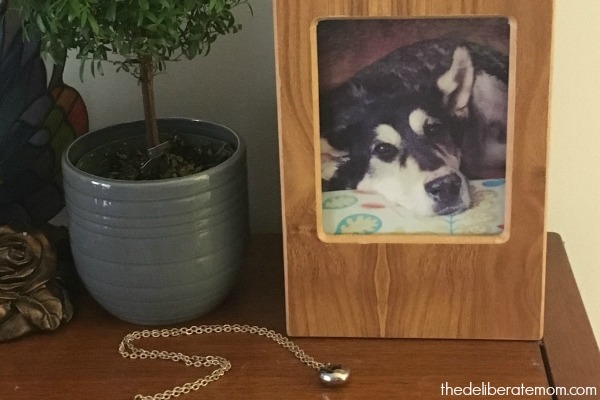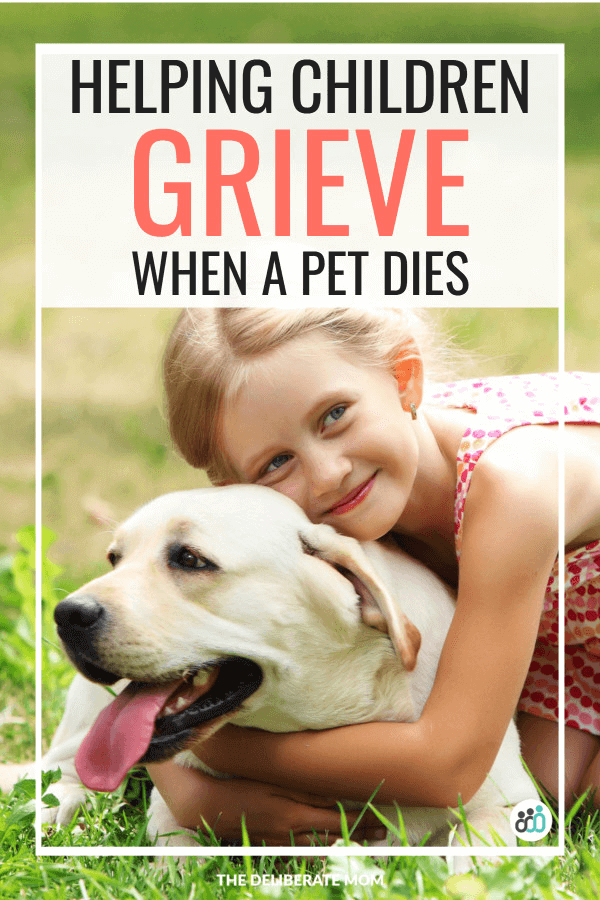When a pet dies, grief is inevitable. As a parent, the event of a pet’s death can be especially challenging, as you and your child are both going through the grieving process. Here are some ways to support your child when their pet dies.
HELPING CHILDREN GRIEVE AFTER A PET DIES
We knew it was coming. We saw our dog’s health decline steadily over the course of a year. When the veterinarian gave the poor prognosis, it wasn’t surprising, but it was still devastating. It was Maverick’s last day and it was time to say goodbye to this dear, most beloved, furry friend.
I’ll never forget the phone call from my husband. He was at the vet’s office and told me that this was the end for our dog. I told my girls that Maverick was dying and took their hands in mine as we walked four blocks to the vet’s office. The sun was shining down on us but our eyes were raining tears. My oldest daughter wailed all the way to the clinic.
Once we arrived, we all took turns feeding Maverick handfuls of treats. We hugged him and said our goodbyes. Then I left with my two girls before the euthanasia took place… my husband stayed behind to be with Maverick until the end.
My girls and I walked those four long blocks home… gut-wrenching sobs coming from all three of us. Watching my girls struggle with grief was one of the hardest things I ever had to do as a parent.
The loss of a pet is often a child’s first encounter with death. The way their grief is managed becomes a cornerstone upon how future losses are handled. Here are some suggestions on how to help your child through the grieving process when their pet dies.
The death of a pet is hard. Here are some ways to help children grieve. #parenting Click To TweetThe death of your pet is going to hurt.
Death hurts.
But watching your children grieve hurts twice as much.
As parents we often want to fix things and take away the pain.
It’s important to realize that death isn’t something we can fix or make better. Unfortunately, grieving is a process. Our role as parents is to appropriately comfort our children as much as we can.
Children grieve in all sorts of ways. We need to allow them to go through all the emotions of this painful time and help them feel supported in their grief.
Grief may look unusual.
Children perceive things differently than adults. They may not seem grieved at all, or they may go from gut-wrenching crying to jovial playfulness within seconds.
Be supportive of all the ways your child may be processing their grief.
If your child is crying… let them cry. Don’t try to “make it better”.
If your child doesn’t seem bothered by the loss of the pet, draw near to them, play with them, and colour with them. Allow them opportunities to talk and share their feelings with you.
If your child’s emotions seem to be on a yo-yo, recognize that this is normal too. Children have shorter attention spans than adults. They may get distracted momentarily by an activity, but then be reminded of their pet’s death minutes later.
Regardless of how your child grieves, make yourself available to them. Listen to their sorrows, hug them, let them know that they’re not alone in this sad and frightening time.
Expect questions about death.
As mentioned previously, the death of a family pet is often a child’s first encounter with death. Their stable world has been rocked by something irreversible and out of their control.
As a child begins to process the death of their pet, it may stir deeper questions and fears in them:
- If my dog dies, then does that mean Mommy and Daddy will die too?
- Will I die?
- What happens when someone dies?
- What happened to my cat after it died?
It’s important to expect these sorts of questions and to respond in the most transparent and honest way possible.
Your spiritual beliefs will be the anchor by which you respond to your children’s questions. If you feel unable to answer a question, then it’s okay to tell your child that you’re unsure.
I wrestled with my oldest daughter’s biggest question; she wanted to know if she would see Maverick in Heaven.
I honestly told her that I didn’t know for sure. But I did share with her how we, as Christians, are assured of a place in Heaven, but the Bible says nothing about pets. However, as we discussed this topic further, we came to the conclusion that if God gave us animals for our enjoyment, wouldn’t it make sense that these beloved animals would be in Heaven too?
The process of seeking answers and thoughtful discussion was reassuring, healing experience for both of us.
Let yourself grieve the loss of your pet.
When Maverick died, my own grief was my biggest struggle. I wanted to hide my grief because I didn’t want to upset my daughters by expressing my own grief.
However, after some careful reflection, I realized that by sharing my grief, it would give my girls an opportunity to communicate their own feelings of remorse.
I specifically recall coming into the house a few days after Maverick’s death. The stairwell landing he normally slept on looked so empty. Tears immediately came to my eyes. I didn’t hide my sadness and my girls could identify with my grief as well. My oldest daughter said, “I always expect to see him laying there too, Mom.”
It’s important that we share our grief with our children as it gives them an opportunity to observe others’ grieving processes. Also, communicating our personal feelings of grief often helps children feel safe in expressing their own remorse.

Find ways to remember your pet.
One of the most vital steps to our grieving process was to find ways to remember Maverick’s life. He was a big 100 lb presence in our lives and his gentle, furry face, was immediately missed.
We looked for meaningful ways to commemorate our furry companion of 10 years. Since Maverick was cremated, we purchased a picture frame urn to hold his ashes. We also bought cremation necklace pendants for us and our girls, which would also hold a tiny sampling of Maverick’s ashes.
As we presented the necklaces to our girls, my husband explained that we could wear our necklaces whenever we wanted to remember Maverick, like on a family walk or for a special celebration.
We also explained how the photo urn holds his ashes too. It sits on the piano in our living room and we look at it often.
Other ways to remember a pet may be to:
- Have a pet “funeral”.
- Work together to assemble a memory photo album of your pet.
- Share stories about your pet.
- Assemble a slideshow of pictures and put it to music.
- Make a donation to the local animal shelter in honour of your pet.
- Bury some ashes in your pet’s favourite spot outside (under a tree, in the corner of the yard, etc.)
Use other resources to help with grief.
Another way to support your child through their grieving process is to seek other helpful resources. There are many picture books available which address pet loss.
You may also want to consult a professional counselor if your child’s grief seems to go on for a really long time, or dramatically affects their activities and interest in life.
Grief is one of the most challenging things we go through as parents. However, with patience, love, keen observation, and ample attention, your child will eventually come through the grieving process. Allow your child, and yourself, plenty of time and grace… one day the memories of your beloved pet will provide much joy and comfort to all of you.










Aw, Jennifer I am so sorry for the loss of your beloved dog, Maverick. I still can recall when my childhood dog, taffy had to be put to sleep so many years later still now. From that I definitely agree with your assessment of grief for kids with the death of a pet. And although, our dog, Elsa is still pretty young and healthy so far, we have suffered the loss of fish (plural) here. The first time out for my girls was rough. But thankfully they seem to be getting a bit stronger since having gone through this a few more times. I am not sure, but even following all tips from our local pet store, we still are struggling with maintaining a pet fish. So, I do appreciate your advice here and will definitely keep in mind if need be with our fishy issues. Thanks again and hope you are having a good week so far xoxo <3
This was such a hard post to write. I loved Maverick so much and I think of him often. Thank you for the kind words and condolences.
My daughter’s first experience with death was my grandmother, which was really difficult. Then our cat passed away last June. Probably about a year ago. You’re so right about grief looking unusual. I imagine it does with me too. She didn’t seem that bothered, but to this day, she still can draw tears about the cat!
Grief is completely unpredictable… especially with children. They say and do the oddest things sometimes while they’re processing their loss.
Thanks for sharing your thoughts on this Tamara.
I have a friend who lost a cat recently, and it took her weeks of grieving, and she’s planning to travel 15 hours away to buy the cat’s little sister. Great advice here, Jen.
I’m glad you for the advice helpful April. Dealing with the death of a pet is so hard. I truly feel for your friend.
Thank you for this! We said goodbye to our sweet dog today. Though we knew it was coming, it still took us by surprise when the time finally came. My husband is preaching in the Philippines, so I had to do this all my myself, with four sobbing children looking on. I discussed Heaven in the same way you did. That brought us comfort. We played Pandora “Hymns” station as she was going through the process. I begged the Lord to help me and the kids let go and the song “I need Thee Every Hour” (Fernando Ortega) began to play. The Lord was so good to us, because indeed we needed His strength in that moment!
It’s true, each of them is grieving in their own way. It was hard, as a mommy, to watch a little of their innocence be taken away today.
Oh I’m so sorry for your loss. I’m glad this article was helpful. Sending you and your family love, hugs, and comfort.